Servicios Personalizados
Revista
Articulo
Indicadores
-
 Citado por SciELO
Citado por SciELO
Links relacionados
-
 Similares en
SciELO
Similares en
SciELO  uBio
uBio
Compartir
Boletín de la Sociedad Argentina de Botánica
versión On-line ISSN 1851-2372
Bol. Soc. Argent. Bot. v.44 n.1-2 Córdoba ene./jul. 2009
Asteraceae visited by honeybees in Argentina: a record from entomopalynological studies
María C. Telleria
1 LASBE- Laboratorio de Sistemática y Biología Evolutiva (CONICET), Museo de La Plata, Paseo del Bosque s/no, 1900 La Plata, Argentina.
1 MACN- Laboratorio de Actuopalinología, Museo Argentino de Ciencias Naturales, Avenida Ángel Gallardo 470, C1405 Ciudad de Buenos Aires.
e-mail: mariatelleria@fcnym.unlp.edu.ar
Summary: Entomopalynological studies of Asteraceae in Argentina revealed that 64 taxa occurred in food stored by honeybees. The most visited plant tribes were classified according to both the type of reward provided by the different taxa and the intensity that such reward is collected by honeybees. Exotic plant taxa were intensely visited inside the disturbed areas (e.g. Cardueae and Cichorieae tribes), whereas native taxa (e.g. Barnadesioideae, Mutisieae, Astereae and Eupatorieae) were intensely visited in less disturbed areas. A large number of identified taxa of Asteraceae and the evaluation of its importance to honeybee nutrition were presented. The present study contributes to the knowledge of relationship between Asteraceae and honeybees.
Key words: Pollen; Nectar; Asteraceae; Apis mellifera; Phytogeographical regions; Argentina.
Resumen: Asteraceae visitadas por abejas melíferas en Argentina: un registro a partir de estudios entomopalinológicos. A partir de estudios entomopalinológicos se encontró que 64 taxa pertenecientes a la familia Asteraceae están presentes en los alimentos almacenados por las abejas melíferas. Los representantes exóticos fueron intensamente visitados en las áreas más alteradas (e.g. Cardueae and Cichorieae), mientras que algunos representantes nativos (e.g. Barnadesioideae, Mutisieae, Astereae y Eupatorieae) fueron intensamente visitados en áreas menos alteradas. Se presenta un importante número de taxa de Asteraceae relevantes para la nutrición de las abejas melíferas. El presente trabajo contribuye a conocer la relación entre Asteraceae y abejas melíferas.
Palabras clave: Polen; Néctar; Asteraceae; Apis mellifera; Regiones fitogeográficas; Argentina.
INTRODUCTION
Asteraceae is the most diverse of all plant families of Angiosperms; it includes 1700 genera and ca. 24000-30000 species of global distribution in almost all terrestrial ecosystems except for Antarctica (Funk et al., 2005). Although it is known that the pollen of Asteraceae is carried by different vectors such as insects, birds and wind (e.g. Faegri & van der Pijl, 1979), there are a few works about its pollination. Asteraceae present some difficulties in experimental handling, and have unremarkable pollination syndrome when compared with other families such as Orchidaceae (Lane, 1996). Entomopalynology provides a useful mean to study the relationship between insects and flowers (Jones & Jones, 2001) and, in our case, may contribute to knowledge of the interaction between Asteraceae and a generalist insect as the honeybee.
In Argentina, Asteraceae nowadays has 227 genera and ca. 1400 species (Katinas et al., 2007). Based on a significant number of entomopalynological publications that have been conducted in this country, we know that pollen of Asteraceae - beside of Fabaceae - is commonly present in honey and pollen loads collected by Apis mellifera. The purpose of the present article was to compile the information about the Asteraceae visited by honeybees in Argentina in order to obtain a record of (1) the different tribes which are represented in the food composition, (2) the taxa that provide nectar, pollen or both of them at the same time and, (3) if there is any relationship between the phytogeographical distribution of plant tribes and their use by honeybees.
Data were obtained from entomopalynological studies which have been conducted in different phytogeographical regions of Argentina (Cabrera, 1971). Most studies deal with the botanical origin of honey and pollen loads. We considered that the pollen present in honey comes from plants visited to obtain nectar, whereas the pollen present in corbicular loads came from plants visited to obtain pollen.
MATERIALS AND METHODS
Data for the present record were obtained from studies supported by pollen reference collection, using the acetolysis technique (Erdtman, 1960) during treatment of samples. In addition, some of the studies of botanical and geographical origin of honey included detailed morphological analysis of pollen collected by honeybees (Andrada, 2001; Fagúndez, 2001, Fagúndez & Caccavari, 2003; Forcone, 2002a; Tellería, 1995; Tellería, 2000; Tellería & Forcone, 2002). In order to evaluate taxa as source of nectar, the following criteria were considered (1) if the percentage of pollen in the honey belongs to the dominant taxa (considered as "very important", with more than 15 % of total counted pollen according to Louveaux, 1978), (2) if the percentage of pollen in the honey belongs to the minor or trace category (considered as "secondary important", with less than 15 % of total pollen counted). The evaluation of taxa as supplier of pollen was assigned in several papers (Andrada, 2001, 2003; Andrada & Tellería, 2005; Basilio, 2000; Forcone, 2002a, b; Tellería, 1993). Phytogeographical regions follow the scheme of Cabrera (1971) (Fig. 1). Update of botanical names follows Zuloaga & Morrone (1999).

Fig. 1. Phytogeographical regions of Argentina where entomopalynological studies were carried out.
RESULTS
In Argentina, most of the entomopalynological studies were carried out in relation to the botanical and geographical origin of honey, being scarce those made on pollen loads. The number of studies realized inside the phytogeographical regions is related to development of apiculture. Regions where this activity is more intensive such as Pampeana, Caldenal, and Monte have been the best studied; in consequence there is abundant information. On the other hand, there is little information in the Chaquena region where the plants visited by honeybees has been poorly studied until now (Table 1).
Table 1. Number of samples studied in different phytogeographical provinces.
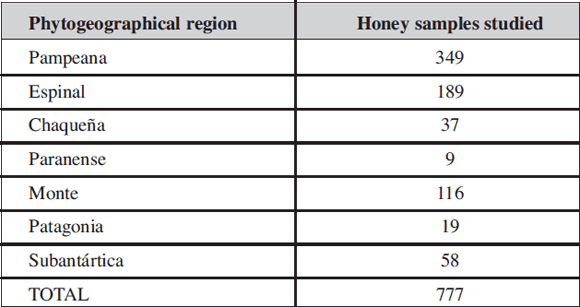
Three subfamilies of Asteraceae were present in honey and pollen loads: Asteroideae, Cichorioideae and Barnadesioideae. From 64 morphological types 39 were determined at species level, 19 at genus and 6 at tribe level (Table 2).
Table 2. Asteraceae visited for nectar or pollen in different phytogeographical regions of Argentina. ++ very important, + secondary important. * introduced plants.
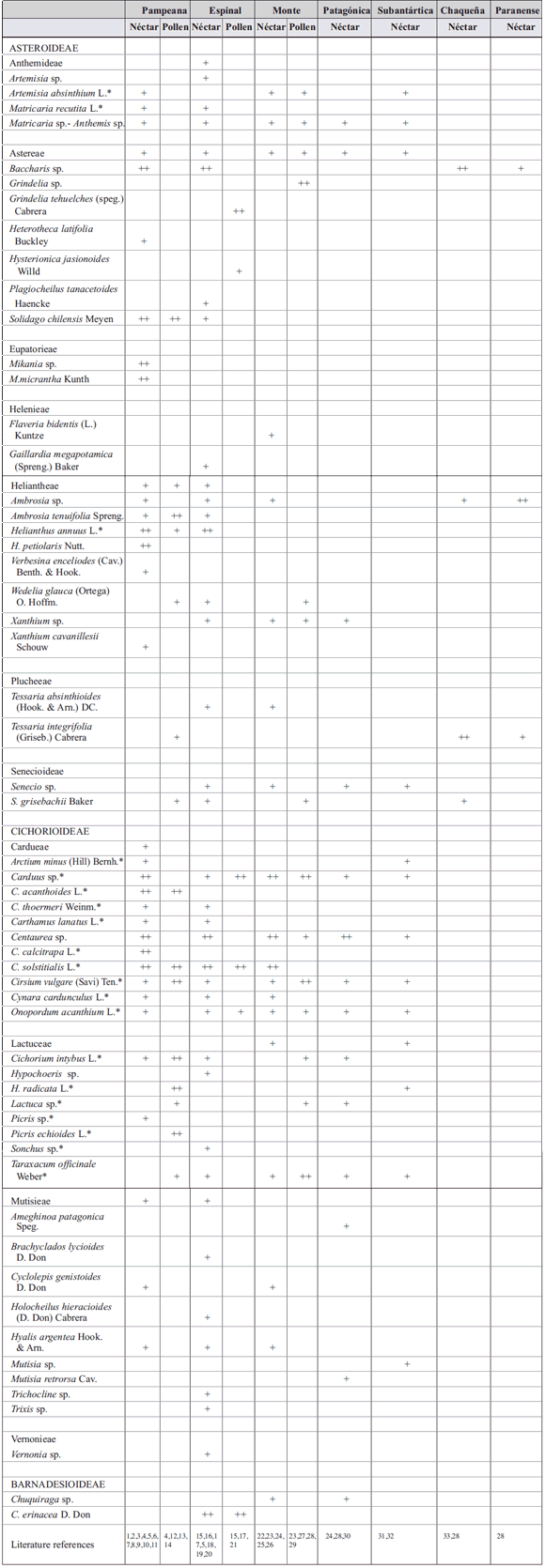
Literature references : (1) Andrada et al. (1998 a); (2) Andrada et al. (1998 b); (3) Basilio and Romero (1996); (4) Basilio (1998); (5) Lusardi et al. (2005); (6) Tellería (1998); (7) Tellería (1992); (8) Tellería (1995); (9) Tellería (1996); (10)Tellería (2000); (11) Valle et al. (1995); (12) Basilio (2000); (13)Naab (1993); (14) Tellería (1993); (15) Andrada (2001); (16) Andrada and Tellería (2002); (17) Andrada (2003); (18) Naab et al. (2001); (19) Salgado and Pire (1999); (20) Tamame and Naab (2003); (21) Andrada and Tellería (2005); (22) Fagúndez and Caccavari (2003); (23) Fagúndez (2003); (24) Forcone and Tellería (1998); (25) Tellería and Forcone (2000); (26) Tellería and Forcone (2002); (27) Fagúndez and Caccavari (2006); (28) Forcone (2002a); (29) Forcone (2002b); (30) Forcone and Tellería (2000); (31) Forcone (2003); (32) Forcone et al. (2005); (33) Salgado and Pire (1998).
The large number of identification at the species level was achieved by different reasons: (1) it was the only species in that area or the only species available during the apicultural period, (2) the pollen has had specific diagnostic features and, (3) the field observations. These observations were especially important to identify pollen from pollen loads. For instance, in the northwest of the Pampeana region Centaurea solstitialis and Centaurea calcitrapa live together and they cannot be distinguished from pollen features; however the colour of pollen loads allowed us to identify both species. Pollen loads are yellow if they to came from C. soltitialis whereas they are slightly violet if they came from C. calcitrapa (Tellería, 1993).
Taxa of Asteraceae used by Apis mellifera
The diversity of Asteraceae in different phytogeographical regions of Argentina is displayed by the pollen grains from the honey and corbicular pollen loads produced by honeybees. From 16 tribes currently recorded in Argentina (Katinas et al., 2007), 9 are represented in the honeybee food. In honey and pollen loads from Pampeana, Espinal, Monte and Patagonica regions, Asteraceae was found to be highly represented whereas it was scarcely represented in Chaquena and Subantártica regions (Table 2; Figs 2-5).
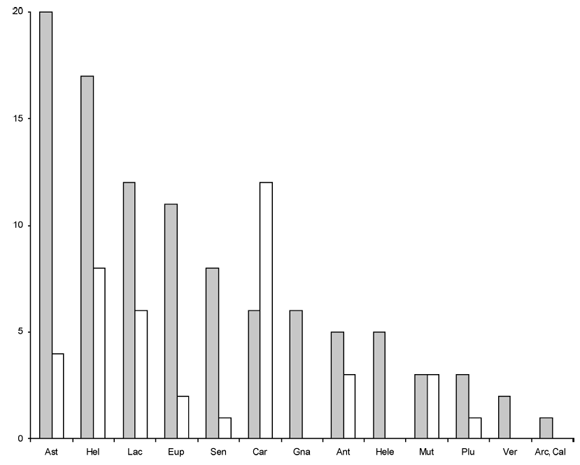
Fig. 2. Tribes of Asteraceae in the Pampeana region. Ast: Astereae; Lac: Lactuceae; Hel: Heliantheae; Car: Cardueae; Sen: Senecioideae; Mut: Mutisieae; Hele: Helenieae; Gna: Gnaphalieae; Ant: Anthemideae; Eup: Eupatorieae; Plu: Plucheae; Bar: Barnadesioideae; Cal: Calenduleae. ![]() % of species present. .
% of species present. .![]() % of species visited by honeybees.
% of species visited by honeybees.
Cardueae, Lactuceae and Anthemideae are the tribes more used by honeybees in all regions. Coincidently, these tribes comprise the highest number of exotic species (Katinas et al., 2007), and most of them are invasive plants. Cardueae is represented by "thistles" (Carduus sp., Cirsium sp., Cynara sp. and Onopordum sp.) and "knapweed" (Centaurea sp.), both invasive plants, native from Europe, that are very common in cattle breeding and disturbed areas. For this reason, honeys from Argentina usually contain thistle and knapweed pollen. Lactuceae, which is represented by "dandelion" and "chicory" among others, is an important pollen supplier. Pollen from Anthemidae, mainly "chamomille" (Matricaria sp., Anthemis sp.) is common in the honey as traces. Concerning Heliantheae, Helianthus annuus, "sunflower", is the species mostly utilized by honeybees which collect its nectar and pollen. Capitula of Ambrosia sp. are wind pollinated and they lack nectar, however they are intensely visited regarding its pollen at the end of the summer when other attractive resources are scarce. Pollen of Ambrosia appears frequently in the honey as trace.
The other tribes appearing in honeybee collections showed high number of native species, such as Barnadesieae, Mutisieae, Astereae, Eupatorieae, Plucheeae, Helenieae, Senecioideae and Vernonieae. Within this group, Barnadesieae and Mutisieae are common in Patagonica region (Fig. 5), and are geographical markers of honey produced in this region. Barnadesieae tribe was only represented by Chuquiraga sp.; this species was an important source of pollen and nectar in Patagonia, south of Monte (Fig. 3) and Espinal (Fig. 4) regions. The Mutisieae tribe was common in Espinal and Monte regions, the latter evidenced a larger diversity of species, and this fact was reflected in honeybee collections. Astereae, Eupatorieae, Plucheeae tribes are similar in pollen features (Skvarla et al., 1977) however in some cases, due the abundance and availability of some species, it was able to recognize species (e.g. Solidago chilensis, Heterotheca latifolia among others). Within Eupatorieae, only Mikania was recognized as important source of nectar in Delta del Paraná where it is abundant. Plucheeae, represented by Tessaria sp., is very used in Chaquena region. Helenieae and Vernonieae tribes are scarcely used; Senecioideae is more common in foods reserves of honeybees.
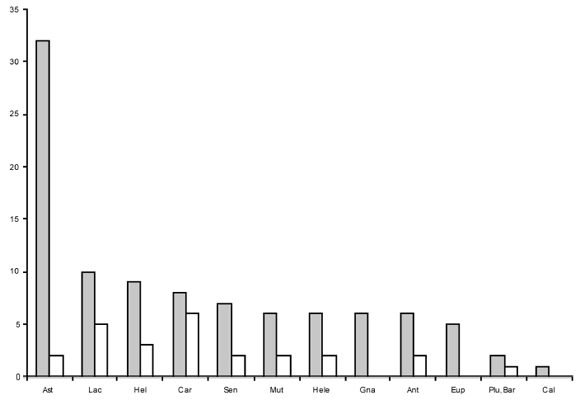
Fig. 3. Tribes of Asteraceae in the Monte region. ![]() % of species present.
% of species present. ![]() % of species visited by honeybees.
% of species visited by honeybees.
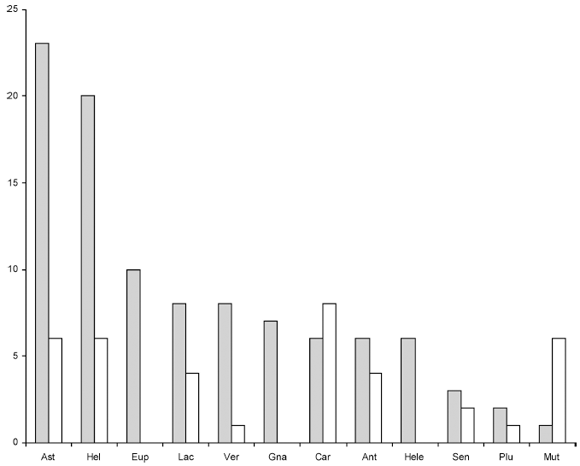
Fig. 4. Tribes of Asteraceae in the Espinal region. ![]() % of species present.
% of species present. ![]() % of species visited by honeybees.
% of species visited by honeybees.
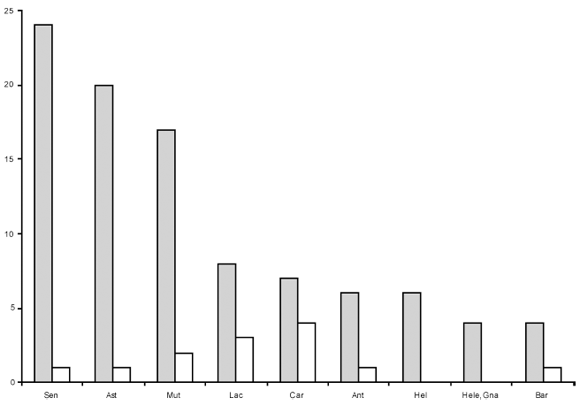
Fig. 5. Tribes of Asteraceae in the Patagonia region. ![]() % of species present.
% of species present. ![]() % of species visited by honeybees.
% of species visited by honeybees.
Arctoteae and Calenduleae tribes did not appear in the collects. Both tribes only have exotic representatives (Katinas et al., 2007), and they are uncommon comparing to others which are more frequent in the collects.
CONCLUSIONS
Entomopalynological studies from Argentina have shown an insight into the relationship between honeybees and the Asteraceae family.
- From 16 tribes of Asteraceae recorded, 9 of them were found to be present in food reserves of honeybees.
- The number of tribes represented in food resources was high concerning Pampeana, Espinal, Monte and Patagonia regions, though it was found to be low in Subantarctic and Chaquena regions, probably due to a poor sampling when compared to that in other regions.
- Exotic representatives were mostly present in those collections belonging to Cardueae, and Lactuceae tribes as well as Heliantheae which was mainly represented by the sunflower (Helianthus annuus).
- Tribes of Astereae, Eupatorieae and Plucheeae were likely sub represented due to their similar palynological features.
- The most visited native representatives were Barnadesieae, Mutisieae, Astereae, Eupatorieae and Plucheeae tribes and in a minor extent to Senecioideae, Helenieae and Vernonieae.
- A large number of taxa were found to be visited for obtaining both pollen and nectar, whereas other taxa provided only one type of reward. It must be noted that Astereae was shown to be pollennectariferous, Cardueae and Mutisieae were nectariferous, and Lactuceae was polliniferous.
- Although certain tribes may be underestimated, results might indicate that exotic invasive species of Asteraceae were mostly visited by honeybees rather than native species with the exception of some less disturbed areas such as Delta del Paraná and Patagonia. Most invasive plants are dominant in different environments and their flowering produces a strong visual impact. Similar results have been reported by Krend & Murphy (2003) studying the relationships between Apis mellifera and both native and exotic plants in Boulder, Colorado (USA). It is known that the introduction of honeybees along with invasive plants has had many negative implications to the native plants because they may cause the decline of native pollinators. In Argentina much remains to be elucidated about the relationships between exotic bees and native Asteraceae, however the knowledge of visited taxa of the sunflower family could be the first step to develop further studies on particular species.
ACKNOWLEDGEMENTS
I thank M. Barth for English improvements.
BIBLIOGRAPHY
1. ANDRADA, A. C., A. F. VALLE, E. M. ARAMAYO, S. A. LAMBERTO & M. CANTAMUTTO. 1998a. Análisis polínico de las mieles de las sierras australes de la Provincia de Buenos Aires, Argentina. Prod. Prot. Veg. 13: 265- 275. [ Links ]
2. ANDRADA, A. C., A. F. VALLE, E. M. ARAMAYO & S. A. LAMBERTO. 1998b. Espectro polínico de las mieles de la región de Bahía Blanca, Provincia de Buenos Aires, Argentina. Polen 9: 75-84. [ Links ]
3. ANDRADA, A. 2001. Estudio de la flora melífera y polinífera en la zona sur del Distrito del Caldén, Provincia del Espinal. Ph.D. thesis, Departamento de Biología, Bioquímica y Farmacia, Universidad Nacional del Sur. [ Links ]
4. ANDRADA, A. C. 2003. Flora utilizada por Apis mellifera L. en el sur del Caldenal (Provincia fitogeográfica del Espinal), Argentina. Rev. Mus. Argentino Cienc. Nat., n.s. 5: 329-336. [ Links ]
5. ANDRADA, A. C. & M. C. TELLERIA. 2002. Botanical origin of honey from south of Caldén district (Argentina). Grana 41: 58-62. [ Links ]
6. ANDRADA, A. C. & M. C. TELLERIA. 2005. Pollen collected by (Apis mellifera L.) from south of Calden district (Argentina): botanical origin and protein content. Grana 44: 115-122. [ Links ]
7. BASILIO, A. 1998. Estudio melitopalinológico de los recursos alimentarias y de la producción de un colmenar en la región del delta del Paraná. Ph.D. thesis, Facultad de Ciencias Exactas y Naturales, UBA. [ Links ]
8. BASILIO, A. M. 2000. Cosecha polínica por Apis mellifera (Hymenoptera) en el bajo Delta del Paraná: comportamiento de las abejas y diversidad del polen. Rev. Mus. Argentino Cienc. Nat., n.s. 2: 111-121. [ Links ]
9. BASILIO, A. M. & E. J. ROMERO. 1996. Contenido polínico en las mieles de la región del Delta del Paraná (Argentina). Darwiniana 34: 113-120. [ Links ]
10. CABRERA, A. L. 1971. Fitogeografía de la República Argentina. Bol. Soc. Argent. Bot. 14: 1-30. [ Links ]
11. ERDTMAN, G. 1960. The acetolysis methods. A revised description. Svenk. Bot. Tidskr. 39: 561-564. [ Links ]
12. FAEGRI, K. & L. PIJL VAN DER. 1979. The principles of pollination ecology, 3rd revised edition Pergamon Press, Oxford. [ Links ]
13. FAGUNDEZ, G. A. 2001. Estudio palinológico de Asteraceae (Angiospermas) frecuentes en mieles de Entre Ríos, Argentina. Asoc. Paleont. Arg. Publ. Esp. 8: 85-90. [ Links ]
14. FAGUNDEZ, G. A. 2003. Diagnosis polínica de especies características de mieles "de isla" de la Provincia de Entre Ríos, Argentina. Rev. Mus. Argentino Cienc. Nat., n.s. 5: 351-361. [ Links ]
15. FAGUNDEZ, G. A. & M. A. CACCAVARI. 2003. Caracterización polínica y organoléptica de algunas mieles monoflorales del centro de la provincia de Entre Ríos, Argentina. Polen 12: 77-95. [ Links ]
16. FAGUNDEZ, G. A. & M. A. CACCAVARI. 2006. Pollen analysis of honey from the central zone of the Argentine province of Entre Ríos. Grana 45: 305-320. [ Links ]
17. FORCONE, A. 2002a. Fuentes de néctar y polen utilizadas por Apis mellifera en el valle inferior del río Chubut (Argentina). Ph.D. thesis, Departamento de Biología, Bioquímica y Farmacia, Universidad Nacional del Sur. [ Links ]
18. FORCONE, A. 2002b. Bee-collected pollen in the lower valley of the Chubut river (Argentina). Bol. Soc. Argent. Bot. 37: 251-259. [ Links ]
19. FORCONE, A. 2003. Plantas nectaríferas utilizadas por Apis mellifera L. en la Patagonia extra-andina, Argentina. Rev. Mus. Argentino Cienc. Nat., n.s. 5: 363-369. [ Links ]
20. FORCONE, A. & M. C. TELLERIA. 1998. Caracterización palinológica de las mieles del valle inferior del río Chubut (Argentina). Darwiniana 36: 81-86. [ Links ]
21. FORCONE, A. & M. C. TELLERIA. 2000. Caracterización palinológica de las mieles de la llanura del río Senguerr (Chubut- Argentina). Darwiniana 38: 267-271. [ Links ]
22. FORCONE, A., G. AYESTARAN, A. KULSCHKER & J. GARCIA. 2005. Palynological characterization of honeys from the Andean Patagonia (Chubut, Argentina). Grana 44: 202- 208. [ Links ]
23. FUNK, V. A., R. J. BAYER, S. KEELEY, R. CHAN, L. WATSON, B. GEMEINHOLZER, E. SCHILLING, J. L. PANERO, B. G. BALDWIN, N. GARCIA-JACAS, A. SUSANNA & R. K. JANSEN. 2005. Everywhere but Antarctica: Using a supertree to understand the diversity and distribution of the Compositae. Biol. Skr. 55: 343-374. [ Links ]
24. JONES, G. D. & S. D. JONES. 2001. The uses of pollen and its implication for Entomology. Neotropical Entomology 30: 341-350. [ Links ]
25. KATINAS, L., D. G. GUTIERREZ, M. A. GROSSI & J. V. CRISCI. 2007. Panorama de la familia Asteraceae (= Compositae) en la República Argentina. Bol. Soc. Argent. Bot. 42: 113-129. [ Links ]
26. KREND, K. & C. MURPHY. 2003. The relationship of Apis mellifera with exotic and native plants in Boulder County, Colorado. American Journal of Undergraduate Research 2: 5-11. [ Links ]
27. LANE, A. L. 1996. Pollination biology of Compositae. In: Caligari, P. D. S. & D. J. N. Hind (Eds.), Compositae: Biology & Utilization. Vol. 2. Proceeding of the International Compositae Conference. Kew. 1994, pp. 61-80. Royal Botanic Gardens, Kew. [ Links ]
28. LOUVEAUX, J. 1978. Methods of Melissopalynology by International Commission for Bee Botany of IUBS. Bee World 59: 139- 157. [ Links ]
29. LUSARDI, M., D. PRADO & S. GATTUSO. 2005. Contenido polínico de las mieles del sur de la provincia de Santa Fe (Argentina). Bol. Soc. Argent. Bot. 40: 85- 90. [ Links ]
30. NAAB, O. A. 1993. Análisis polínico de mieles de la Provincia de La Pampa, Argentina. Actas de las Jornadas pampeanas de Ciencias Naturales, 3-5. [ Links ]
31. NAAB, O. A., M. A. CACCAVARI, H. TROIANI & A. PONCE. 2001. Melisopalinología y su relación con la vegetación en el departamento de Utracán, La Pampa, Argentina. Polen 11: 99-113. [ Links ]
32. SALGADO, C. R. & S. M. PIRE. 1998. Análisis polínico de mieles del Noroeste de la Provincia de Corrientes (Argentina). Darwiniana 36: 87-93. [ Links ]
33. SALGADO, C. R. & S. M. PIRE. 1999. Contribución al conocimiento del contenido polínico de mieles de Corrientes. Ameghiniana 6: 95-99. [ Links ]
34. SKVARLA, J. J., B. L. TURNER, V. C. PATEL & A. S. TOMB. 1977. Pollen morphology in the Compositae and in morphologically related families. In: Heywood, V., J. B. Harborne & B. L. Remes (Eds.), The Biology and Chemistry of the Compositae, Vol. 1, pp. 141-248. Academic Press, London. [ Links ]
35. TAMAME, M. A. & O. A. NAAB. 2003. Mieles monoflorales pampeanas de Condalia microphylla Cav. y Centaurea solstitialis L. análisis melisopalinológicos relacionados con los caracteres fisicoquímicos. Rev. Mus. Argentino Cienc. Nat., n.s. 5: 371-381. [ Links ]
36. TELLERIA, M. C. 1988. Analyse pollinique des miels du Nord- Ouest de la Province de Buenos Aires (République Argentine). Apidologie 19: 275-290. [ Links ]
37. TELLERIA, M. C. 1992. Caracterización botánica y geográfica de las mieles de la provincia fitogeográfica pampeana (República Argentina) I: Distrito Oriental. Darwiniana 31: 345-350. [ Links ]
38. TELLERÍA, M. C. 1993. Floraison et récolte du pollen par les abeilles domestiques (Apis mellifera L. var ligustica) dans la pampa argentine. Apidologie 24: 109-120. [ Links ]
39. TELLERIA, M. C. 1995. El polen de las mieles del noroeste de la Provincia de Buenos Aires. Darwiniana 33: 347-364. [ Links ]
40. TELLERIA, M. C. 1996. Caracterización botánica y geográfica de las mieles de la provincial fitogeográfica pampeana (República Argentina) II: Tandilla. Bol. Soc. Argent. Bot. 32: 91-94. [ Links ]
41. TELLERIA, M. C. 2000. Contribución a la identificación del polen de las mieles pampeanas. Bol. Soc. Argent. Bot. 34: 205-216. [ Links ]
42. TELLERIA, M. C. & A. FORCONE. 2000. El polen de las mieles del valle de Río Negro, provincia fitogeográfica del Monte (Argentina). Darwiniana 38: 273- 277. [ Links ]
43. TELLERIA, M. C. & A. FORCONE. 2002. Morfología del polen de las mieles del valle de Río Negro, Río Chubut y llanura del río Senguerr (Patagonia- Argentina). Bol. Soc. Argent. Bot. 37: 235-250. [ Links ]
44. VALLE, A. F., A. C. ANDRADA, E. M. ARAMAYO & S. A. LAMBERTO. 1995. Análisis polínico de las mieles del sudoeste de la provincia de Buenos Aires, Argentina. Prod. Prot. Veg. 10: 375-382. [ Links ]
45. ZULOAGA, F. O. & O. E. MORRONE. 1999. II Acanthaceae- Euphorbiaceae (Dicotyledonae), pp. 98- 353. Catálogo de las plantas vasculares de la República Argentina. Monographs of Systematics Botany from the Museum Botanical Garden 74. [ Links ]
Recibido 25 de septiembre de 2008
Aceptado 20 de febrero de 2009.














